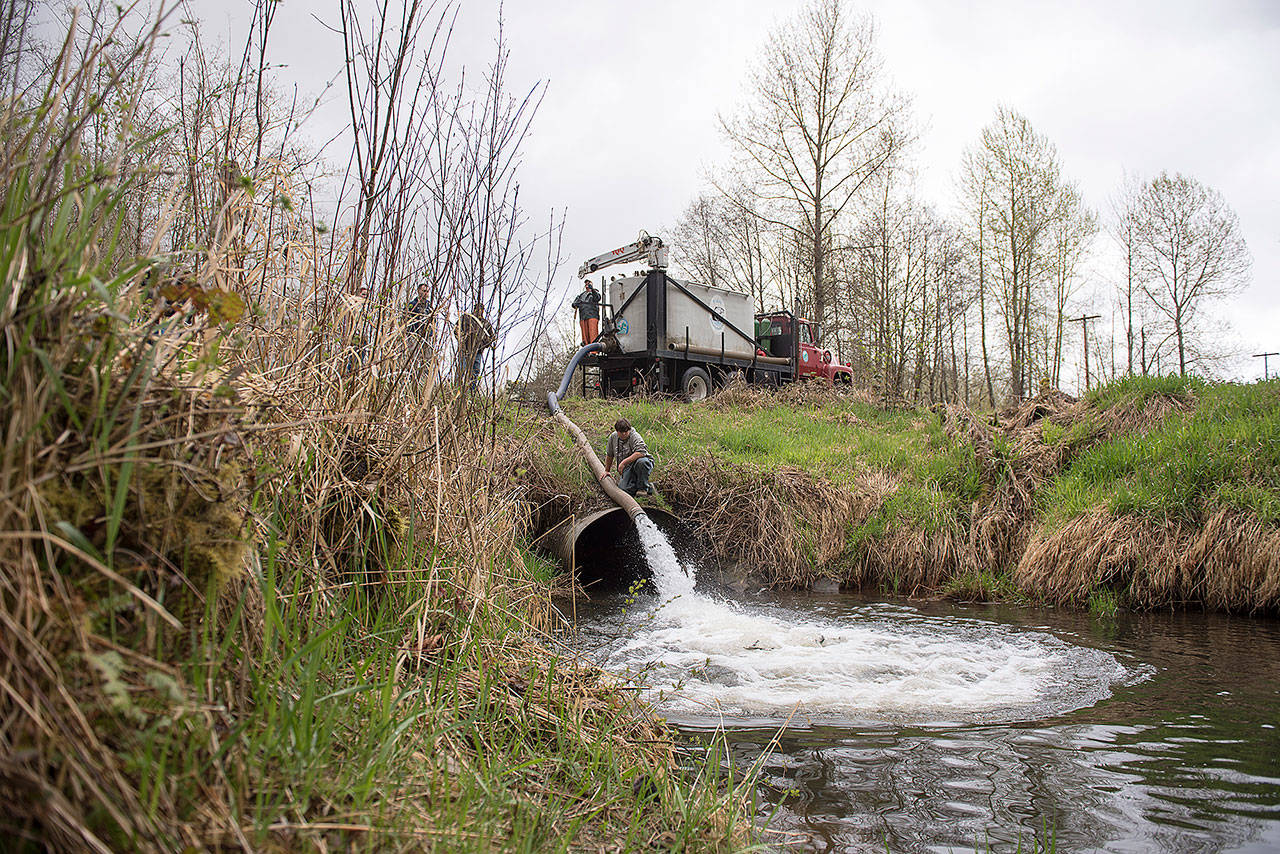Onalaska High School’s hatchery program — the only one of its kind in Washington — this week released 25,000 steelhead that will make their way to the Chehalis River and return for years to come to the Grays Harbor waterway.
“The students have these fish for about 14 months, raising them from eggs all the way up to this size,” said Kevin Hoffman, aquaculture teacher at Onalaska High School. “They feed them, they clean the tanks, they take their average size, just being a husband to the fish. … They have turned out really good — really good quality.”
Students in the Onalaska High School aquaculture program — run by Hoffman — are learning advanced aquaculture practices. Hoffman supervises the high school students, who operate the hatchery on school grounds. Before he obtained his teaching certificate and began at Onalaska High School three years ago, Hoffman worked in private industry for eight years.
Now, he works with the Washington Department of Fish & Wildlife (WDFW) as well as the Chehalis Tribe to supervise students in the high school’s hatchery.
The district has a cooperative agreement with WDFW — the department gives Hoffman fish and feed, then the students raise the fish. Additionally, the Chehalis Tribe helps finance the program to pay for feed for a portion of the fish, as well as money every year to buy oxygen for the tank. In return, the program produces more fish.
Hoffman said there are about 42 students in his aquaculture program at Onalaska High School.
Wednesday morning, four joined him and two WDFW employees to release the steelhead.
“These four actually do pretty well,” Hoffman said. “I think they enjoy it. Or they enjoy the donuts and the extra credit — one of the two.”
Riley Christianson, a junior, said it was her first year in the class. She said that she was randomly placed in the class, and thinks she may want to go to cosmetology school after she graduates.
“Mostly we just maintain the fish, clean the tanks, feed them,” Christianson said. “I check the DOs which is the dissolved oxygen levels so they (the fish) can breathe while they swim.”
When asked to describe how much her class knew about maintaining a fish hatchery when they started, she responded, “Well, we were clueless.”
“Half the class is freshmen, so now we’re more on a routine,” Christianson said. “Like, feed them (the fish) regularly, hand feed them 5 pounds every day — clean the feeders, clean the tanks.”
Just after 10 a.m., the crew had released about 12,500 steelhead smolts into Gheer Creek, which feeds into the Newaukum River, which goes into the Chehalis River. Two people from the WDFW were at Onalaska High School that morning to assist.
Jim Dills, fish hatchery specialist 3 manager at Skookumchuck Hatchery, said he has been an adviser for the Onalaska program about 15 years now.
“It’s grown from basically nothing,” Dills said. “Kevin has took it leaps and bounds from what we started.”
Dills was supervising three students collecting fish from one of the tanks. He said that he comes to Onalaska High School every week to work with the students and check on the fish. Dills brings feed when it’s needed, and looks at the fish to make sure they are healthy. If they aren’t, he brings a pathologist down to look at them.
“You can see the size of these are pretty good,” Dills said. “That’s a pretty good lookin’ steelhead smolt right there.”
Dills said in about another month and a half, he will bring more eggs to the high school and that the program at Onalaska High School is the most advanced high school program he has worked with.
“I have other schools I work with that might have salmon in the classroom, like an aquarium that I bring them little eggs and they hatch them in an aquarium,” Dills said. “… This may be the only school in the state to this scale that does this.”
Hoffman said he hopes for the high school’s coho return to be from 1 to 3 percent. Every April, they release 100,000 coho smolts and get back from 1, 000 to 3,000 each year, he said. With the steelhead, it’s a bit trickier.
“It’s a little more difficult, because where we trap our steelhead is in Gheer Creek, which is just a small tributary,” Hoffman said. “We believe that most of the steelhead probably go straight up the strip to Newaukum. So we haven’t gotten back any steelhead yet, but we are just now starting to release a sizable number of fish.”
When Hoffman began teaching at Onalaska High School, the students released 5,000 steelhead that first year. The following year, they released 15,000. Now, they are up to 25,000.
Dills echoed that the high school’s program has yet to release enough fish to see returns.
“They are escape artists,” said Hoffman of steelhead. “So we thought we did see some in the trap but you come back the next day and they’re gone. They’re just really elusive fish, but we are hoping to see more returns.”



